|
|
|
1.
|
Quadrilateral JKLM is symmetric with
respect to the y axis.
If the coordinates of K are
(6, 1), what are the coordinates of M? | 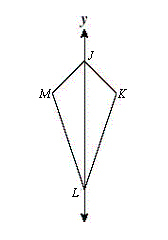 | | |
A) | (–6, –1) | B) | (–1, –6) | C) | (–6, 1) | D) | (–1,
6) |
|
|
|
2.
|
Triangle J’K’L’ is:  A) | a reflection of triangle JKL across the y-axis only. | B) | a translation of
triangle JKL across the x-axis | C) | a reflection of triangle JKL across the x-axis
only. | D) | a 180 degree rotation of triangle JKL about the
origin |
|
|
|
3.
|
A parallelogram is located entirely in quadrant II. If this parallelogram is
reflected across the origin, in which quadrant will the new parallelogram be located?
|
|
|
4.
|
Which of the following letters has neither vertical or horizontal line
symmetry?
E Z H B
|
|
|
5.
|
Which polygon shown below has only one line of symmetry?  A) | Rectangle ABCD | C) | Square KLMN | B) | Hexagon EFGHIJ | D) | Triangle OPQ |
|
|
|
6.
|
If triangle KLM is reflected across the y-axis to form triangle K’L’M’, what is the coordinate
of K' ?
| 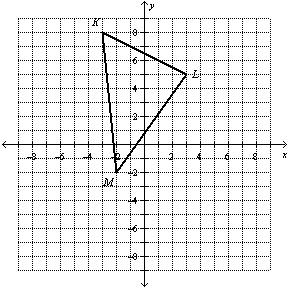 | | |
A) | (8, –3) | B) | (3, 8) | C) | (3, –8) | D) | (–3,
–8) |
|
|
|
7.
|
DUVW was obtained from DRST by rotation about the
point H.
Which of the following indicates the correspondence of the
vertices? | 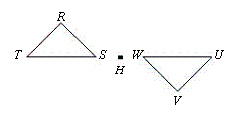 | | |
A) | R ® U, S ® V, T ®
W | C) | R ® U, S ® W, T ®
V | B) | R ® V, S ® W, T ®
U | D) | R
® W, S ®
U, T ®
V |
|
|
|
8.
|
Triangle RST was transformed into
Triangle R´S´T´.
Which term
most accurately describes the transformation? | 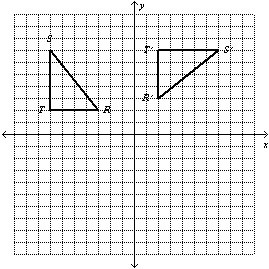 | | |
A) | Rotation | B) | Reflection | C) | Tessellation | D) | Translation |
|
|
|
9.
|
This figure is apparently | symmetric with respect to: |  | | |
A) | the x-axis only | C) | both the x-axis and the y-axis | B) | the y-axis
only | D) | neither the x-axis nor
the y-axis |
|
|
|
10.
|
Equilateral triangle FGH has the measures shown.
What is the maximum number of different
lines of symmetry that can be drawn through D FGH? | 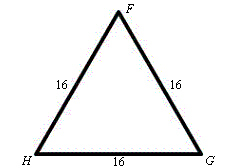 | | |
|
|
|
11.
|
In relation the figure in the second quadrant, the other figure is apparently a
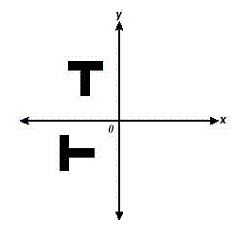
A) | reflection across the y-axis | B) | reflection across the
x-axis | C) | translation across the x-axis | D) | 90° counter-clockwise rotation about the
origin |
|
|
|
12.
|
DB'C'D' is apparently the
result of: 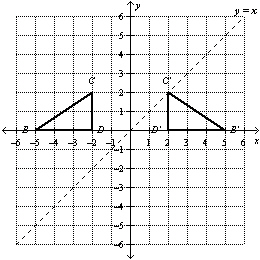
A) | reflecting DBCD across the line
y=x | C) | rotating DBCD about the point (–2,
0) | B) | reflecting DBCD across the
x-axis | D) | reflecting
DBCD across the y-axis |
|
|
|
13.
|
Given: Triangle ABC with vertices
located at A(1, 1), B(2, -3), and
C(-1, -4).
Triangle ABC will be reflected over the line y =
x.
What will be the integral coordinates of point C' after this
transformation?
|
|
|
14.
|
How many different lines of symmetry does a regular hexagon
have?
|
|
|
15.
|
All the vertices of the hexagon have
integral coordinates.
One
of the lines of symmetry for the hexagon goes through: | 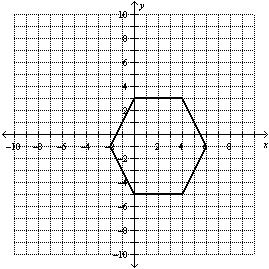 | | |
A) | (0, –5) and (4, 3) | C) | (4, 4) and (4,
–5) | B) | (3, 3) and (3, –5) | D) | (2, 3) and (2, –5) |
|
|
|
16.
|
The polygon A’B’C’D’E’ is 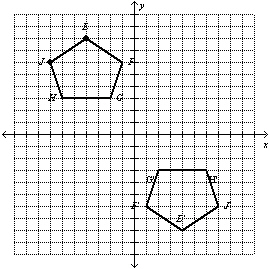 A) | a reflection of EFGHJ across the y-axis | C) | a translation of EFGHJ across the
x-axis | B) | a reflection of EFGHJ across the x-axis | D) | a reflection across the
orgin |
|
|
|
17.
|
A regular quadrilateral has what type of
symmetry?
A) | Line symmetry only | C) | Both
point and line symmetry | B) | Point symmetry
only | D) | Neither point nor line symmetry |
|
|
|
18.
|
In the drawing: | Triangle
S´T´U´ is: | 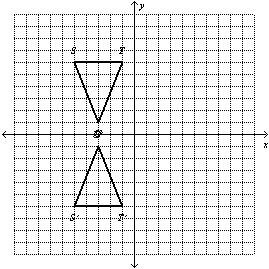 | | |
A) | a reflection of triangle STU across the x-axis | B) | a translation of
triangle STU across the y-axis | C) | a 180 clockwise rotation of triangle STU about
the origin | D) | a reflection of triangle STU across the y-axis |
|
|
|
19.
|
Triangle E’F’G’ is apparently: A) | a translation across the x-axis of triangle EFG | B) | reflection across
the x-axis of triangle EFG | C) | a 90° clockwise rotation about the origin
of triangle EFG | D) | reflection across the y-axis of triangle
EFG |
|
|
|
20.
|
If parallelogram ABCD is translated so that | the new location of point D is (0, –3), what would
be the new location of point B? | 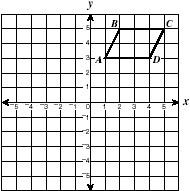 | | |
A) | (–3, –3) | B) | (–2, –1) | C) | (1, –1) | D) | (–4,
–6) |
|
|
|
21.
|
Triangle F' G' H' is a transformation of triangle FGH.
If  F', F',  G', and G', and  H', H',  F'G'H' is a: F'G'H' is a: | 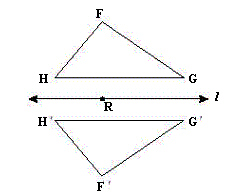 | | |
A) | reflection of DFGH across the line
l | C) | translation of DFGH across the line
l | B) | 180° rotation of DFGH
about point R | D) | 90° rotation of DFGH
across the line l |
|
|
|
22.
|
A) | (2, –1) | B) | (1, –2) | C) | (1,
2) | D) | (–1,
–2) |
|
|
|
23.
|
Hexagon ABCDEF is apparently symmetric with respect to 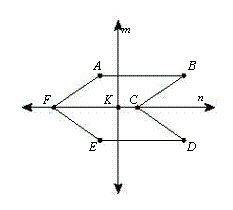 A) | point K only. | C) | line m only. | B) | line n only. | D) | both lines m and n
only. |
|
|
|
24.
|
The figure shown is apparently | symmetric with respect to: |  | | |
A) | line b only | C) | both lines b and c | B) | line c
only | D) | neither line b
nor line c |
|
|
|
25.
|
Which transformation could move the
| triangle H to triangle
H’ in a single step? |  | | |
A) | Reflection over x = 4 | C) | Translation | B) | Rotation about (2,3) | D) | Reflection over y =
4 |
|